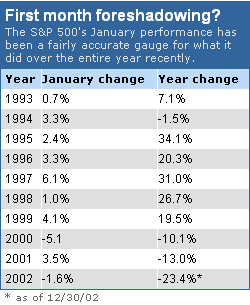In case you've never heard of it before, January has historically been great at telling us what the market has in store for the year. Although we at BigTrends don't necessarily believe this, it's interesting to look at anyway. There are 2 popular theories around. One is that January is a good predictor and the other is that the first 5 days of the year is a good predictor.
The January Barometer has been more effective than the first 5 days method. Since 1950, we've only seen 4 major errors. That doesn't include 6 years during which the market was flat or in a range, with gains and losses of less than 5%. The S&P 500 was up just slight in January 1966 but ended down 13%. In 1968 and 1982, January was down, but the market had gains greater than 5%. 2001 was another year where the indicator was wrong because January saw an increase and yet the market was down over 10% for the year.

The First 5 Days
Another popular January observation is the first five days. From 1950 to 2000, January gains worked as a good predictor of the annual gains for the market. There were only 3 exceptions, and they all seemed related to war. The gulf war put a dent in returns in 1990, military spending in 1966 slowed down the bear market, and ceasefire early in 1973 raised stocks early in the year. During the same period, 19 January's started off with losses and 9 of those years ended down.
Now this sounds all nice and dandy, but just as we discussed in our "What Causes What?" article a few weeks ago, not all highly correlated items involve causation. You'll have to ask yourself, "does a down January cause the market to go down for the year?" We would argue that it does but only to the extent of the downward movement. In other words, if the market is down 5% in January, that increases the probability of a down year, but we believe it has little predictive value. On an optimistic note, this past week ended up around 3% for the S&P 500 and that certainly has many investors excited. If recent history is any guide, this should indeed be good news for the stock market in 2006.
Price Headley is the founder and chief analyst of BigTrends.com.